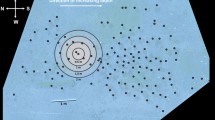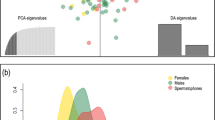Abstract
Molecular techniques enable the study of patterns and processes that are difficult to study using other methods. Specifically, population connectivity, taxonomic status and genetic mating systems can be clearly defined using these techniques. In this paper, the genetic mating system of Stegastes acapulcoensis (Fowler Fishes Acad Nat Sci Phila Monographs 6: 57–529, 1944) in the Mexican central Pacific (17–19°N, 101–105°W) was analyzed using four nuclear microsatellite loci. In this species, males are territorial and prepare a rocky substrate for spawning with the females, who oviposit tens of thousands of eggs that attach to the substrate with adhesive threads. Once a nest has been established, the male exhibits parental care to protect the eggs from predation until the larvae hatch. Twenty nests were collected from nest-guarding territorial males during the period from 2010 to 2011, and the numbers of female donors of the gametes in these nests were determined. The most common mating system found in this species was polygyny involving two to six females per nest. Larger males exhibited higher reproductive success than smaller males, guarding larger nests with more eggs from more females. Some males in this species exhibited parasitic behavior.







Similar content being viewed by others
References
Abramoff MD, Magalhaes PJ, Ram SJ (2004) Image processing with ImageJ. Biophoton Int 11:36–42
Allen GR, Robertson DR (1998) Peces del Pacífico oriental tropical. Conabio, Agrupación Sierra Madre y Cemex, Ciudad de México
Angilletta MJ, Dunham AE (2003) The temperature-size rule in ectotherms: simple evolutionary explanations may not be general. Am Nat 162:332–342
Atkinson D, Sibly RM (1997) Why are organisms usually bigger in colder environments? Making sense of a life history puzzle. Trends Ecol Evol 12:235–239
Avise JC, Liu JX (2010) Multiple mating and its relationship to alternative modes of gestation in male-pregnant versus female-pregnant fish species. Proc Natl Acad Sci U S A 107:18915–18920
Avise JC, Jones AG, Walker D, DeWoody JA (2002) Genetic mating systems and reproductive natural histories of fishes: lessons for ecology and evolution. Annu Rev Genet 36:19–14
Colbourne JK, Neff BD, Wright JM, Gross MR (1996) DNA fingerprinting of bluegill sunfish (Lepomis macrochirus) using (GT)n microsatellites and its potential for assessment of mating success. Can J Fish Aquat Sci 53:342–349
Coleman SW, Jones AG (2011) Patterns of multiple paternity and maternity in fishes. Biol J Linn Soc 103:735–760
DeWoody JA, Avise JC (2001) Genetic perspectives on the natural history of fish mating systems. J Hered 92:167–172
DeWoody JA, Fletcher DE, Wilkins SD, Nelson WS, Avise JC (1998) Molecular genetic dissection of spawning, parentage and reproductive tactis y population of redbreast sunfish Lepomis auritus. Evolution 52:1802–1810
DeWoody JA, Walker D, Avise JC (2000a) Genetic parentage in large half-sib clutches: theoretical estimates and empirical appraisals. Genetics 154:1907–1912
DeWoody JA, DeWoody YD, Fiumera AC, Avise JC (2000b) On the number of reproductives contributing to a half-sib progeny array. Genet Res Camb 75:95–105
DeWoody JA, Fletcher DE, Wilkins SD, Avise JC (2000c) Parentage and nest guarding in the tessellated darter (Etheostoma olmstedi) assayed by microsatellite markers (Perciformes: Percidae). Copeia 3:740–747
DeWoody JA, Fletcher DE, Mackiewicz SD, Wilkins SD, Avise JC (2000d) The genetic mating system of spotted sunfish (Lepomis punctatus): mate numbers and the influence of male reproductive parasites. Mol Ecol 9:2119–2128
Emlen ST, Oring LW (1977) Ecology, sexual selection, and the evolution of mating systems. Science 197:215–223
Fisher JAD, Frank KT, Leggett WC (2010) Global variation in marine fish body size and its role in biodiversity–ecosystem functioning. Mar Ecol Prog Ser 405:1–13
FitzSimmons NN, Moritz C, Moore SS (1995) Conservation and dynamics of microsatellite loci over 300 million years of marine turtle evolution. Mol Biol Evol 12:432–440
Fiumera AC, Porter BA, Grossman GD, Avise JC (2002) Intensive genetic assessment of the mating system and reproductive success in a semi-closed population of the mottled sculpin, Cottus bairdi. Mol Ecol 11:2367–2377
Fowler HW (1944) Results of the fifth George Vanderbilt expedition (1941) (Bahamas, Caribbean Sea, Panama, Galápagos archipelago and Mexican Pacific islands). Fishes Acad Nat Sci Phila Monographs 6:57–529
Griffith SC, Owens IP, Thuman KA (2002) Extra pair paternity in birds: a review of interspecific variation and adaptive function. Mol Ecol 11:2195–2212
Helfman GS, Collette BB, Facey DE, Bowen BW (2009) The diversity of fishes. Biology, evolution and ecology, 2nd edn. Wiley-Blackwell, New Jersey
Hoelzer GA (1990) Male-male competition and a female choice in the Cortez damselfish Stegastes rectifraenum. Anim Behav 40:339–349
Hoelzer GA (1992) The ecology and evolution of partial-clutch cannibalism by paternal Cortez damselfish. Oikos 65:113–120
Hughes C (1998) Integrating molecular techniques with field methods in studies of social behavior: a revolution results. Ecology 79:383–399
JMP (n.d.) Version 8, SAS Institute, Cary, NC 1989–2007
Jones AG (2005) GERUD 2.0: a computer program for the reconstruction of parental genotypes from half-sib progeny arrays with known or unknown parents. Mol Ecol Notes 5:708–711
Jones AG, Walker D, Lindström K, Kvarnemo C, Avise JC (2001) Surprising similarity of sneaking rates and genetic mating patterns in two populations of the sand goby experiencing disparate sexual selection regimes. Mol Ecol 10:461–469
Karino K (1995) Male-male competition and female mate choice through courtship display in the territorial damselfish Stegastes nigricans. Ethology 100:126–138
Karino K, Nakazono A (1993) Reproductive behavior of the territorial herbivore Stegastes nigricans (Pisces: Pomacentridae) in relation to colony formation. J Ethol 11:99110
Knapp RA, Kovach JT (1991) Courtship as an honest indicator of male parental quality in the bicolor damselfish, Stegastes partitus. Behav Ecol 2:295–300
Knapp RA, Warner SS (1991) Male parental care and female choice in the bicolor damselfish, Stegastes partitus: bigger is not always better. Anim Behav 41:747–756
Kokko H, Rankin DJ (2006) Lonely hearts or sex in the city? Density-dependent effects in mating systems. Philos Trans R Soc B 361:319–334
Mackiewicz M, Fletcher DE, Wilkins SD, DeWoody JA, Avise JC (2002) A genetic assessment of parentage in a natural population of dollar sunfish (Lepomis marginatus) based on microsatellite markers. Mol Ecol 11:1877–1883
Mackiewicz M, Porter BA, Dakin EE, Avise JC (2005) Cuckoldry rates in the Molly miller (Scartella cristata; Blenniidae), a hole nesting marine fish with alternative reproductive tactics. Mar Biol 148:213–221
Mascolino S, Benvenuto C, Gubili C, Sacchi C, Boufana MS (2016) The ART of mating: alternative reproductive tactics and mating success in a nest-guarding fish. J Fish Biol 148:2643–2657
Meekan MG, Ackerman JL, Wellington GM (2001) Demography and age structures of coral reef damselfishes in the tropical eastern Pacific Ocean. Mar Ecol Prog Ser 212:223–232
Mobley KB, Jones AG (2009) Environmental, demographic, and genetic mating system variation among five geographically distinct dusky pipefish (Syngnathus floridae) populations. Mol Ecol 18:1476–1490
Peakall R, Smouse PE (2006) GENALEX 6: genetic analysis in excel. Population genetic software for teaching and research. Mol Ecol Notes 6:288–295
Picciulin M, Verginella L, Spoto M, Ferrero EA (2004) Colonial nesting and the importance of the brood size in male parasitic reproduction of the Mediterranean damselfish Chromis chromis (Pisces: Pomacentridae). Environ Biol Fish 70:23–30
Reisser CM, Beldade R, Bernardi G (2009) Multiple paternity and competition in sympatric congeneric reef fishes, Embiotoca jacksoni and E. lateralis. Mol Ecol 18:1504–1510
Sikkel PC (1988) Factors influencing spawning site choice by female Garibaldi, Hypsypops rubicundus (Pisces: Pomacentridae). Copeia 3:710–718
Smith C, Wootton RJ (1995) The costs of parental care in teleost fishes. Rev Fish Biol Fish 5:7–22
Souza LLG, Chellappa S, Gurgel HCB (2007) Biologia reprodutiva do peixe-donzela, Stegastes fuscus Cuvier, em arrecifes rochosos no nordeste do Brasil. Rev Bras de Zool 24:419–425
Taborsky M (1994) Sneakers, satellites and helpers: parasitic and cooperative behavior in fish reproduction. Adv Study Behav 23:91–100
Taborsky M (1998) Sperm competition in fish: “bourgeois” males and parasitic spawning. Trends Ecol Evol 13:222–227
Taborsky M (2001) The evolution of bourgeois, parasitic, and cooperative reproductive behaviors in fishes. J Hered 92:100–110
Taborsky M (2008) Alternative reproductive tactics in fish. In: Oliveira RF, Taborsky M, Brockmann HJ (eds) Alternative reproductive tactics: an integrative approach. Cambridge University Press, New York, pp 251–299
Thiessen RJ, Heath DD (2007) Characterization of one trinucleotide and six dinucleotide microsatellite markers in bicolor damselfish, Stegastes partitus, a common coral reef fish. Conserv Genet 8:983–985
Urbiola-Rangel E, Chassin-Noria O (2013) Conectividad genética de Stegastes acapulcoensis (Pomacentridae) en el Pacífico central de México. Hidrobiológica 23:415–419
Van Oosterhout C, Hutchinson WF, Wills DPM, Shipley P (2004) Micro-checker: software for identifying and correcting genotyping errors in microsatellite data. Mol Ecol Notes 4:535–538
Williams DA, Purcell J, Hughes CR, Cowen RK (2003) Polymorphic microsatellite loci for population studies of the bicolor damselfish, Stegastes partitus (Pomacentridae). Mol Ecol Notes 3:547–549
Wilson AB (2009a) Opening Pandora’s box: comparative studies of genetic mating systems reveal reproductive complexity. Mol Ecol 18:1307–1309
Wilson AB (2009b) Fecundity selection predicts Bergmann’s rule in sygnathid fishes. Mol Ecol 18:1263–1272
Acknowledgments
The authors thank the Laboratorio Nacional de Análisis y Síntesis Ecológica (LANASE, www.lanase.unam.mx) and Dr. Víctor Rocha Ramírez (Instituto de Investigaciones en Ecosistemas y Sustentabilidad-Universidad Nacional Autónonoma de México) for the support provided during the molecular analysis. The authors wish to acknowledge their use of the Maptool program for analysis and graphics in this paper. Maptool is a product of SEATURTLE.ORG (information is available at www.seaturtle.org). This study was supported by the Coordinación de la Investigación Científica – Universidad Michoacana de San Nicolás de Hidalgo and by a grant from the Consejo Nacional de Ciencia y Tecnología, Universidad Nacional Autónoma de México, Universidad Autónoma de Guerrero, Universidad Michoacana de San Nicolas de Hidalgo and the LANASE (2015-250996 and 2016-271449 and 2017-280505). All specimens were collected according to the national legislation and transported to the Colección de Peces de la Facultad de Biología de la Universidad Michoacana de San Nicolás de Hidalgo (CPUM-UMSNH) under Scientific Collection Registry number MICH.-PEC-227-07-09.
Author information
Authors and Affiliations
Corresponding author
Ethics declarations
All applicable international, national and/or institutional guidelines for the care and use of animals were followed.
Conflict of interest
The authors declare that they have no conflicts of interest.
Additional information
Publisher’s note
Springer Nature remains neutral with regard to jurisdictional claims in published maps and institutional affiliations.
Rights and permissions
About this article
Cite this article
Urbiola-Rangel, E., Chassin-Noria, O. Mating and reproductive success associated with male body size in Stegastes acapulcoensis (Teleostei: Pomacentridae). Environ Biol Fish 102, 1473–1483 (2019). https://doi.org/10.1007/s10641-019-00925-z
Received:
Accepted:
Published:
Issue Date:
DOI: https://doi.org/10.1007/s10641-019-00925-z




